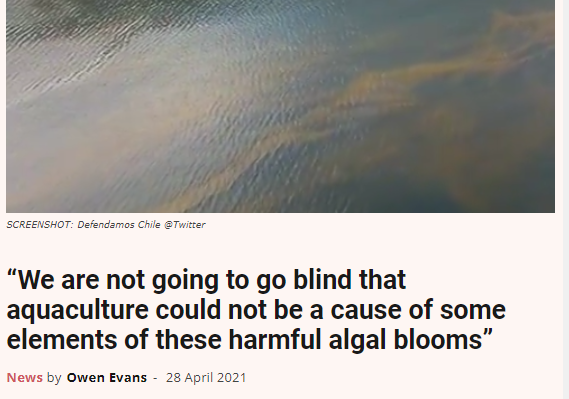 Ömurlegt ástand hefur verið í fjörðum Chile undanfarnar vikur þar sem milljónir eldislaxar hafa kafnað í sjókvíum vegna þörungarblóma. Böndin berast að sjókvíaeldinu sjálfu sem orsök þörungablómans.
Ömurlegt ástand hefur verið í fjörðum Chile undanfarnar vikur þar sem milljónir eldislaxar hafa kafnað í sjókvíum vegna þörungarblóma. Böndin berast að sjókvíaeldinu sjálfu sem orsök þörungablómans.
Mengunin sem streymir frá sjókvíunum er svo gríðarleg að hún veldur óhóflegri aukningu næringarefna sem hleypir ógnarvexti í þang og þörunga. Afleiðingarnar eru að súrefnið í sjónum þverr og brennisteinsvetni fer að myndast með hræðilegum afleiðingum fyrir eldislaxinn sem getur ekki flúið þessar aðstæður.
Skv. umfjöllun Salmon Business hafa allt að 99% laxa drepist á sumum eldissvæðum við Chile. Hér við land batt þörungarblómi enda á sjókvíaeldi í Seyðisfirði á sínum tíma þegar allur fiskur drapst sem þar var alinn.
Í næsta firði, Mjóafirði, voru það marglyttur sem gerðu útum sjókvíaeldið. Nú er verið að reyna að þröngva í gegn leyfum fyrir báða þessa firði á nýjan leik og fyrri viðvörunarmerki náttúrunnar höfð að engu.
„Are there oceanographical or geographical differences where Chilean fish farming could have played a part in the spread of algae blooms?
The past few weeks in Chile have seen a dramatic rise in mortalities due to the presence of toxic algae blooms.
Mortality
The most recent death toll of fish has put it at 7,408 tonnes. Involved are sites belonging to Mowi, Aquachile, Yadran, Multiexport, Granja Marina Tornagaleone and Salmones Camanchaca.
The publication El Divisadero reported that a fisheries and aquaculture engineer said that harmful algae bloom events are becoming more common and “we are not going to become the blind that aquaculture could not be a cause.
Increase
Dr. Paulina Montero is a part of the Patagonia Ecosystem Research Center (CIEP), a government-supported body that “contributes to the sustainable development of the Aysén Region through scientific research of excellence and relevant to the interests of the community and productive sectors”.
She told the publication that “what we cannot deny, is that lately there has been an increase in these algal blooms and there is also no denying that today’s implementation and sampling techniques allow us to have many more points where we can observe these blooms”.
She added that “today it is possible to monitor the behavior of these phenomena through satellite imagery and other tools such as continuous monitoring stations anchored in the fjords”.
Dr. Montero pointed out that as well as natural events there are also “anthropogenic factors, being one of them aquaculture. We are not going to go blind that aquaculture could not be a cause of some elements of these harmful algal blooms, mainly because of the increase in nutrients generated by this industry in the water column.”
Norway
In 2019, the Institute of Marine Research concluded that fish farming cannot possibly be the cause of this algae bloom which killed 7.7 million salmon.
IMR Research Director Dr Karin Kroon Boxaspen told SalmonBusiness that at the time IMR did an analysis of the organic load in the affected areas in Norway for the period in question.
But could there be oceanographical or geographical differences where Chilean fish farming could have play a part in the spread of algae blooms?
Unpredictable
“This showed very clearly that the nutrients from fish farms had a very low added effect on the total nutrient concentration in the area. This is an analysis specifically for the area in question taking into account the background level of nutrients,” she said.
“This background level will be specific to any area and potentially very different from place to place. Along the Norwegian coast, we have an annual spring algal bloom every year. Often this consists of algae-like Emiliana Huxley, a calciferous algae making the sea look “green” like you had poured milk into it. The spring bloom is a natural effect of nutrients coming into the sea from melting snow with it and the increasing level of sunlight. Why in some areas, toxic algae blooms are unpredictable,” concluded Boxaspen.“
